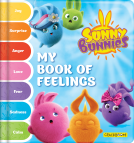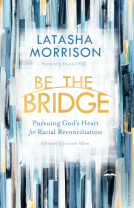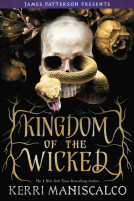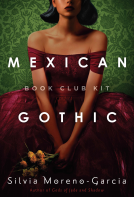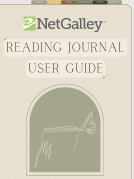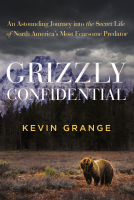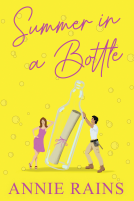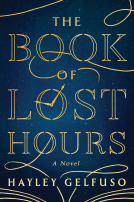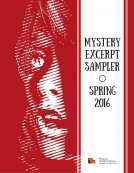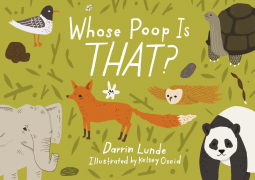
Whose Poop Is That?
by Darrin Lunde
This title was previously available on NetGalley and is now archived.
Send NetGalley books directly to your Kindle or Kindle app
1
To read on a Kindle or Kindle app, please add kindle@netgalley.com as an approved email address to receive files in your Amazon account. Click here for step-by-step instructions.
2
Also find your Kindle email address within your Amazon account, and enter it here.
Pub Date Jan 10 2017 | Archive Date Dec 31 2016
Description
No, don’t say “Ewwww.” Ask, “Whose poop is that?” This simple, and yes, charming book asks this question about seven examples of animal poop. By investigating visual clues, young readers can learn to identify the animal through its droppings. For instance, find a sample of poop with bits of bone and tufts of hair. Turn the page to learn it came from a fox!
Kelsey Oseid’s illustrations are both accurate and beautiful. Backmatter includes further information about the poop and what scientists can learn from an animal’s droppings.
"A primer on poop and a guessing game, especially for those just beyond toilet training" — Kirkus Reviews
"Gross-out details will provoke glee...but kids will learn plenty about the variety and importance of animal waste, too" —Publisher's Weekly
"As accessible to newly independent readers as it is to younger listeners" — Bulletin of the Center for Children's Books
"Sure to appeal to curious youngsters. Recommended for collections that can't get enough titles on poop" — School Library Journal
"The kid-friendly illustrations and matter-of-fact tone make this title an informative, rather than a gross-out, pick, though is certainly what will get kids reaching for the shelves" — Booklist
"Friendly and inviting to novice naturalists" — Horn Book
"What are you waiting for? Come get the “scoop on poop”!" — NSTA Recommends
A Note From the Publisher
Please note: this picture book is not enabled for Kindle. The file format does not play nice with Kindle devices.
Available Editions
| EDITION | Other Format |
| ISBN | 9781570917981 |
| PRICE | $16.99 (USD) |
| PAGES | 32 |
Featured Reviews
 Marzie K, Reviewer
Marzie K, Reviewer
This is a cute introductory book for curious young readers. Poop always fascinates young children and provides an introduction to a bit of animal biology and nutrition here.
I wished the book had somewhat brighter colors, which might appeal more to primary grade children.
 Librarian 356790
Librarian 356790
Fact: kids love gross humor.
This poo-primer will be a big hit with reluctant readers. Kids will show up for the poo humor, and learn some neat zoological facts along the way. I could see this being a hilarious read-aloud to pre-readers.
Another fact: Wombat poop is square shaped. The more you know!
This review will appear on Goodreads and jesstorytime.blogspot.com closer to publication date.
 Tina M, Librarian
Tina M, Librarian
Curious kids will want to find out the scoop on poop. There are many books about animals and what they eat but not many on the tail end of the digestive process. Fun and informative!
Fantastic book for little ones! As we all know little kids have a silly sense of humor. Many times, their sense of humor involves potty talk and especially talk about poop! Could there be a better way to educate them by using a silly premise like this? I don't think so. This book is perfect. My 4 year old son laughed so hard when I told him what book we were reading before bed tonight. 5 stars!
 Reviewer 300725
Reviewer 300725
Ooops! It's a POOP!!
This was a delightful 'stinky' book. Children will learn and laugh while reading this!
I certainly enjoyed it!
**Disclaimer: I received a copy of this book from Netgalley in exchange for an honest review.
 Librarian 320893
Librarian 320893
Poop is a perennial favorite of little kids and Whose Poop Is That? will be too! Funny and informative, Whose Poop Is That? gives factoids about different animals' droppings along with accurate yet not gross illustrations. With a wide range of animals, kids are sure to have fun guessing whose poop that is!
 Kim C, Educator
Kim C, Educator
Whose Poop is That is a short book for very young readers. Poop, or “scat” as trackers call it, is a clue that is used by biologists to study wild animals. Many animals can be identified by their scats, or droppings. Their diet can also be studied by studying the contents of scats. Placement of the scat is also important to many animal species and can offer a clue to the animal’s identity.
This book shows the scats of several species of animals and tells a bit about the animal who made it. It’s a great way to introduce beginning readers to the outdoors and the study of nature. What kid isn’t fascinated by nature? Poop may seem gross to some adults, but really it has quite a few uses in the scientific sense. Who knows? Maybe your child will become inspired by this book at a young age and go on to become a wildlife researcher.
The illustrations are in full color. Each species’ scat is shown and clues are given. For example, the scat might contain bits of bones and fur. Who made it? On the next page, the reader gets the answer to the question. The illustration that reveals the animal shows it in its native habitat, with the scat shown nearby.
The last pages of the book give some interesting facts on poop. These pages are at a higher reading level and are appropriate for a parent to read to the child, until the child gains more reading skill. The rest of the book is written so that young readers can read most of it. They may have a few words to learn, like Galapagos, but it’s not too difficult, especially if the book is read with a parent to help sound out the newer words.
As a professional wildlife tracker, I found the information in this book accurate. The facts at the end are all correctly stated. The pages that show the animal’s tracks are not totally accurate, but you don’t expect field guide quality track illustrations in a children’s book anyway. They are close enough and accurate enough that the reader will see the main features of that species tracks. Besides, the book is really about poop, so the tracks are secondary to the main feature. I think the entire book was well-done and appropriate for the age group it was written for. I recommend it to any parent who wants to begin to introduce their child to the many mysteries and fascinating clues that wildlife leave behind outdoors in nature!
 Marilyn P, Reviewer
Marilyn P, Reviewer
Kid's will love this book! Anything about poop or pee is an instant hit and kids, being curious, want to find out all they can about such "gross" body functions.
Lunde asks the question, "Whose poop is that? " Then through text and illustrations answers that question. He has chosen seven kinds of animals to highlight: fox, African elephant, panda bear, owl, Galapagos tortoises, gull and the extinct ground sloth.
He exposes the animal's food habits and the end results coming out the other "end". For example...
“Whose poop is that? It has a bunch of splinters in it,” Lunde asks, opposite what looks like a pile of pickles. The answer: a panda. “A panda eats mostly bamboo,” he continues. “A panda has to spend most of its day eating in order to get enough energy.”
He cleverly has included at the back of the book some further information, "The Scoop on Poop", and "Animal Poop Facts." The illustrations are done in simple pen and ink and gives the reader a greater understanding of the subject matter. Two fun facts he includes in poop facts are:
"A rabbit sometimes eats its poop in order to digest its food twice", and a wombat's poop is square."
Who knew? Poop identification is very, very interesting indeed.
Perfect for your future zoologist! (5 stars)
What small child doesn't have a great curiosity about poo? I honestly can't say I've met a kid who didn't want to know about it or at least tell me a joke about it. My own kids included. But there are plenty of books about the human kind, so how do you identify some of the animal droppings you discover while out and about?
While this book certainly won't serve as a database it has really terrific facts about why animal poos have the unique shapes, sizes, and content that they do. I'm a little embarrassed to be writing this but even as an adult I was pretty engrossed with the knowledge that was new to me. I really don't want to spoil the one that became the fascinating favorite with my 7-year-old and myself but suffice it to say that if you read this to a kid who loves science I foresee much Googling images of animal feces in your future. (This was pretty cool and not as disgusting as it sounds, I promise).
Not sure what more I can say to convince you teacher, parent, or cool aunt/uncle that this is a book the young reader you share this with will enjoy it. I mean, it's a book about poop and animals and science, a combo that rarely lets me down.
 Allison D, Librarian
Allison D, Librarian
There’s no way this book won’t be popular. Kids love books about poop. This would really be good for the littler kids. There’s actually a lot of information packed into the book.
 Paul M, Reviewer
Paul M, Reviewer
Happy New Year!
Have you ever been walking in the woods and wondered, "Whose poop is that?" Darrin Lunde can help. In Whose Poop is That? he give examples of several animals' poop, beautifully illustrated (ok, not really beautiful. . . . It is poop, after all.) by Kelsey Oseid.
It's short, it's simple, but it does introduce the rather interesting concept of the role of poop in nature. Lunde helpfully advises the reader, however, "You should never touch poop." Because some kids need to be told that.
Thanks to NetGalley and the publisher for the complimentary electronic review copy!
Readers who liked this book also liked:
Silvia Moreno-Garcia
Historical Fiction, Literary Fiction, Sci Fi & Fantasy

